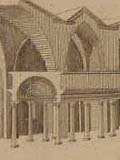Palladio & Fréart
Fréart
In the dedication of this volume, Fréart de Chambray argues that
beauty consists of ‘the union and general accord of all parts together
making a kind of visible harmony.' While the illustration shown is
of the Ionic entablature at the Baths of Diocletian, his analysis is an
intellectual construct. His commentary has none of the empirical rigour
that characterises the later archaeological excavations of the 18th century.
List of items
Palladio 
This drawing of Diocletian's Baths can be traced to Andrea Palladio.
The Bertotti-Scamozzi illustrations in this volume follow those included
by the English architect, Lord Burlington, in his study of the Baths of
the Romans, Fabbriche Antiche (1730). These in turn were based upon drawings
by Palladio that the Englishman had acquired in Italy some years earlier.
Bertotti-Scamozzi had earlier published several volumes documenting Palladio's
buildings.
List of items
Links
Plan of the Baths of Diocletian
Baths of Diocletian. Drawing by Etienne Du Pérac from the mid 16th century.
|
|
|
| Detail. Palladio, Andrea. Le terme dei Romani. Per Giovanni Rossi, 1797. |
|
